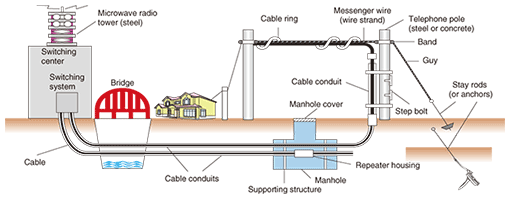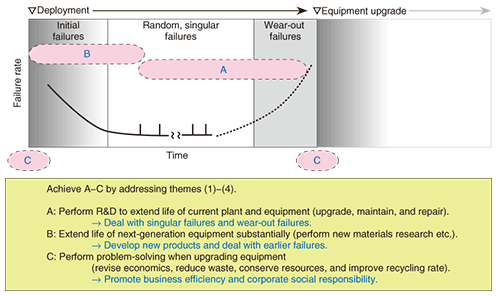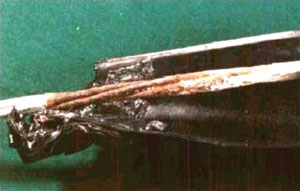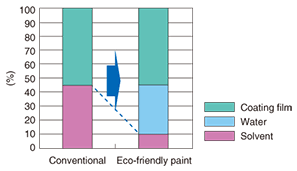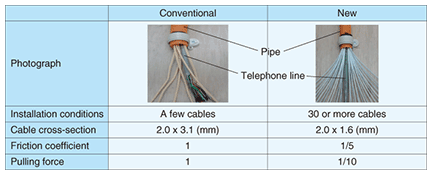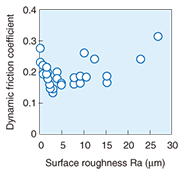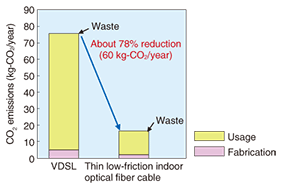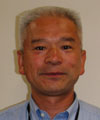 |
|||||||||||||||||||||||||
|
|
|||||||||||||||||||||||||
|
Special Feature: NTT Group R&D for Reducing Environmental Load Vol. 7, No. 10, pp. 19–25, Oct. 2009. https://doi.org/10.53829/ntr200910sf4 Recent Strides to Make Telecommunications Plant More Environmentally Friendly and ReliableAbstractThe Telecommunications Plant Materials Research Group was established in April 2008 with the goal of making telecommunications plant and maintenance technologies more environmentally friendly and reliable. Specifically, this new group is focusing on (1) developing criteria for deciding when to deploy, check, and upgrade telecommunication equipment, (2) clarifying the mechanisms involved in the breakdown and deterioration of materials, (3) developing technologies to enhance the environmentally friendly nature of plant and materials, and (4) developing ties with other laboratories and institutes working on similar materials-related research.
1. Growing obsolescence of NTT’s telecommunications plantTelecommunications has evolved through continuous technological innovations since telephone service was first introduced in Japan in 1890. These days, high-speed communications is commonplace and mobile telephony and optical communications are now mainstream methods. As of the end of 2007, some 88.1 million people in Japan were Internet users, giving an estimated individual penetration rate of 69% [1] and a household penetration rate of 95%. These figures show that information and communications technology (ICT) has become an indispensable aspect of modern-day life. A wide range of ICT services is now available, and these services can effectively reduce CO2 emissions, which are the proximate cause of global warming [2]. The basic physical structures and facilities that make these services possible form the telecommunications infrastructure shown schematically in Fig. 1. Considering the telephone for example, the infrastructure comprises all of the supporting equipment and facilities required to establish a connection between the caller and callee. This infrastructure has sustained telephony from the very beginning right up to the present age of high-speed optical communications, and achieving a high level of reliability through managed maintenance is a constant goal for supporting safe and secure communications services.
Japan’s telecommunications infrastructure was deployed on a massive scale during the post-war era of rapid economic growth from the 1950s–1970s and is now really beginning to show its age. In a 2006 white paper, the Ministry of Land, Infrastructure, Transport, and Tourism, which oversees the nation’s infrastructure—roads, harbors, airports, public housing, waterworks, municipal parks, rivers, shorelines, etc.—concluded that, on the basis of projected costs to maintain and upgrade the infrastructure, the total allocated investment will not be nearly enough and the nation’s aging infrastructure will be beyond upgrading by the year 2030 [3]. NTT is facing similar problems. More than 50% of the company’s conduits were put in the ground at least 30 years ago and are now becoming increasingly obsolete and beginning to fail [4]. Much of its aerial and other outdoor plant—including utility poles, suspended wires, guy wires, and other metal gear and plant—is assumed to be in a similar condition. Since the aging and obsolescence of these kinds of structures could result in serious accidents, ensuring the safety, security, and reliability of the company’s outdoor facilities is a high-priority issue. In particular, in today’s adverse economic climate in which NTT has committed investment to extend fiber to the home (FTTH) to every household in the country, it is important to squeeze the maximum utility out of the company’s equipment by extending its life as much as possible, and NTT must ensure the security, safety, and reliability of all the vast amount of plant and facilities it owns (see Table 1) in order to fulfill its corporate social responsibility.
To address this situation, the Telecommunications Plant Materials Research Group was established at NTT’s Energy and Environment Systems Laboratories in April 2008 specifically to investigate ways to make the structures, plant, and materials used by NTT more reliable and environmentally friendly. This article provides an overview of the specific areas that the new research group is focusing on in fulfilling its mandate and highlights some recent successes. 2. R&D for more easily maintainable structures and plantTo contribute to efforts to make safer, more secure, and more reliable eco-friendly telecommunications plant and materials, the Telecommunications Plant Materials Research Group is focusing on four broad areas taking into account the risk of accidents, technological feasibility, and impact on NTT’s operations: (1) Developing criteria for deciding when to deploy, check, and upgrade telecommunications plant. This involves developing standards optimized in terms of materials science for particular installation environments and defining decision criteria for drafting standards to determine when to deploy, check, and upgrade telecommunications plant. (2) Clarifying the mechanisms involved in the breakdown and deterioration of materials. This involves identifying fracture mechanisms in materials such as high-strength steel used in reinforced concrete utility poles and devising solutions that prevent these problems from occurring. (3) Developing technologies to enhance the environmentally friendly nature of plant and materials. This involves efforts to find more eco-friendly substitutes for existing products that have an adverse effect on the environment by, for example, reducing the volatile organic compounds (VOCs) used in conventional anti-corrosion paint, which is used extensively on microwave radio towers and bridges. (4) Collaborating with other laboratories and institutes working on similar materials-related research. This involves lending materials science support to other laboratories working on telecommunications plant. A conceptual failure-rate curve (bathtub curve) for assessing the reliability of generalized mechanical systems is shown in Fig. 2. The failure rate on the vertical axis is shown as a function of time on the horizontal axis. Mechanical systems have a relatively high likelihood of failing soon after entering service as a result of manufacturing flaws. Systems that survive this initial period experience a long stable period in which the failure rate is dramatically lower. During this period, random or singular failures may occur that could not have been foreseen when the plant was put into service. While one can be relatively successful at reducing manufacturing flaws, failures of the latter kind are often quite difficult to prevent [5]. As wear and tear accumulates with the passage of time, the incidence of wear-out failures increases. In Japan, the public infrastructure is now entering a critical new phase where facilities are wearing out more and more frequently. This is a period of great uncertainty that Japan has not experienced before, so it is extremely important to conduct research and tackle these issues now. The four research areas mentioned earlier were deliberately chosen to address the different failure types identified by the bathtub curve: research on extending the life of existing facilities can help reduce random, singular, and wear-out failures. Research to achieve ultralong lifetimes in next-generation plant (including research on new materials) will help address the problem of early failures in new products, and problem-solving during plant upgrades (including economic upgrades, waste reduction, resource conservation, and recycling rate improvements) will promote better business efficiency and corporate social responsibility. In short, the Telecommunications Plant Materials Research Group is focusing on materials science R&D for the entire life cycle of systems from initial deployment, through mid-life maintenance, to the system upgrade stage. In the rest of this article, we describe some success stories that illustrate the four main concerns of our research group. First, we describe work on crack corrosion exemplifying concerns (1) and (2). Next, we detail a successful effort to develop eco-friendly paint as an example of theme (3). Finally, we discuss the successful development of a low-friction optical cable and access networks that mitigate adverse effects on the environment as examples of theme (4).
3. Crevice corrosion mechanism analysisZinc- or zinc-aluminum-alloy-coated steel is widely used for outdoor structures, including utility poles, suspended wires, guy wires, and other metallic components. The primary cause of deterioration in these structures is atmospheric corrosion when the structure is covered by water or by a water film that creates a corrosion cell, which leads to electrochemical corrosion. It is generally known that zinc or zinc-aluminum alloy coatings protect steel exposed to air by acting as a sacrificial anode for the less active steel and that corrosion resistance can be enhanced by applying a purified coating to the surface of the zinc or zinc-aluminum alloy. It has recently been found that corrosion tends to occur in tiny cracks and crevices at ends, under paint, under paper labels, and in similar places, but this corrosion is nearly impossible to detect by visual checking alone, so it presents a serious maintenance challenge. A photograph of corrosion on an aluminum-clad steel-core wire directly beneath the connecting terminal assembly nozzle—a spot that is very difficult to check visually—is shown in Fig. 3. At crevice sites of these kinds, vapor pressure caused by capillary condensation is reduced compared with the surrounding flat areas, so it takes longer to generate the water film needed to create the corrosion cell, so it is inferred that this causes the corrosion to advance more quickly. To test this hypothesis, we sandwiched two zinc-coated steel plates between plastic spacers to create an artificial crevice sample and then measured the impedance of the sample when it was exposed to 98% humidity at 25ºC. We measured the impedance (actual value) obtained by conduction after 24 hours of exposure. We found that the moisture in the crack increased with time, and apparently some kind of corrosion system was produced from the insulation state, so conduction was obtained. We were thus able to confirm that, even in environments where the humidity does not reach 100%, corrosion can definitely occur in cracks [7]. Although this phenomenon is not likely to cause much immediate damage to actual equipment, these findings add to our store of knowledge regarding the sensitivity of materials exposed to onsite conditions.
4. Eco-friendly paintVolatile organic compounds (VOCs) are toxic to humans, and their indoor use in Japan is beginning to be restricted by the Air Pollution Control Law. The Ministry of the Environment has estimated that Japan produces some 1.5 million tons of VOC emissions per year, with paint accounting for nearly 56% of this total [8]. Anti-corrosion paint that contains VOCs is currently used extensively on many metal outdoor structures such as microwave radio towers and bridges, but its use is likely to be restricting by law in the years ahead. A switchover to more eco-friendly alternative products has emerged as a pressing issue in terms of reducing adverse impact on the environment as well, and this has led to great expectations for the development of eco-friendly paints. We have been pursuing the development of new less-toxic paints by substituting alcohol for the solvents or by reducing the percentage of solvent by partially replacing it by water, as illustrated in Fig. 4, while at the same time making paints that satisfy aesthetic requirements, are extremely long lasting, and provide reasonable cost-performance. We have succeeded in not only reducing the VOCs, but also greatly extending the life of the product. This reduces maintenance costs because the intervals between repainting and upgrading can be increased, reduces operating costs because fewer materials are purchased, and reflects our commitment to corporate social responsibility.
5. Low-friction optical cable and environmentally friendly access networksTo achieve NTT’s Mid-Term Management Strategy, we are now building a high-quality flexible next-generation network and broadband access platform that supports the provisioning of ubiquitous broadband services that meet the diverse needs of customers [9]. One key to this strategy is to extend optical fibers in the access network to homes. Until now, optical lines to multi-dwelling units, which account for close to 40% of households in Japan, have been deployed via either new conduits or existing phone-line conduits. Neither approach is ideal. New conduit construction is expensive and takes time, while the use of existing phone line conduits is also problematic. The phone-line conduits to medium-sized condominium buildings (30–50 households) are only 22 mm in diameter and are already filled with phone lines. This means that only a few indoor optical cables can be deployed in them: not enough to extend fiber to all the families in the building. This led us to develop, in collaboration with NTT Access Service System Laboratories, a thin, low-friction indoor optical cable that can be deployed in existing phone-line conduits. Because the new cables are much thinner and can be deployed in conduits much more smoothly, installers can easily and efficiently deploy 30 cables or more in an existing conduit quickly. The properties of this new cable are compared with those of conventional cable [10] in Table 2.
In developing the new cable, we investigated a new cable sheathing material and optimum surface roughness capable of reducing the outside surface friction of the cable to an absolute minimum, and we developed special measuring equipment to accurately measure the dynamic friction coefficient at the speed at which the cables are pulled into the conduit [11]. The dynamic friction properties of plastic sheeting are usually tested according to the JSA JIS K 7125 standard, and the drawing speed is 100 mm per minute. However, when the cable is actually installed, it is typical pulled into a conduit at a speed ranging from 10 to 30 cm per second, so we had to develop a new measuring device capable of measuring dynamic friction coefficients much more quickly. The new device lets us quantitatively assess the dynamic friction coefficient and surface roughness of various cable structural materials. The relationship between the surface roughness of a polyethylene sheet and the dynamic friction coefficient is shown in Fig. 5. It is apparent that a certain degree of surface roughness is effective for reducing the dynamic friction coefficient, and a surface roughness ranging from 1–10 ¦Ìm yielded a relatively small dynamic friction coefficient in the case of silicone-based materials [11].
Next, we conducted a life cycle assessment of CO2 emissions for a single broadband line used in a medium-sized condominium for one year. The results of this assessment comparing the new thin, low-friction indoor optical cable with a conventional very-high-bit-rate digital subscriber line (VDSL) are shown in Fig. 6. We found that CO2 emissions could be reduced by nearly 80% (60 kg-CO2) over a year by using the new cables. The reason for this huge difference is that when fiber is extended all the way to an optical network unit (ONU) in a home, the optical signal can be received directly, so the VDSL equipment is no longer needed. This difference of 60 kg of CO2 emissions is equivalent to the amount of CO2 absorbed by four cedar trees in a year. The new cable began to be deployed nationwide in December 2008, and it represents one of the key basic technologies in Japan’s FTTH initiative.
6. Future prospectsThe R&D performed by the Telecommunications Plant Materials Research Group will have an enormous impact on society. By developing new technology and adding to the store of existing knowledge about plant and materials and then using that knowledge to create seed technology that can address real onsite maintenance issues, we can contribute to greater business and operating efficiency by reducing plant maintenance costs, our environmental footprint, and our resource consumption and costs. References
|
|||||||||||||||||||||||||








